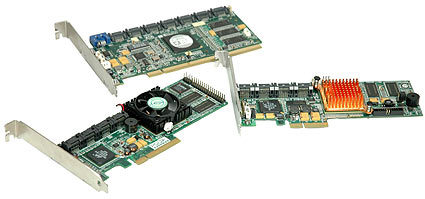Safer 6 for RAID Controllers
The RAID 6 Storage Bodyguards
Redundant Array of Inexpensive/Independent Drives (RAID) is the general solution for requirements in which performance, storage capacity or data safety of a single drive isn't sufficient. While this usually is the case in server systems, workstations and high performance desktops sometimes take advantage of RAID setups as well. Since two or more drives must be used, a RAID array can be somewhat expensive, and this cost can be inflated further depending on your controller choice.
Our recent roundup of eight-channel SATA II RAID controllers revealed that most manufacturers offer great value. However, only one of these cards actually offered a RAID mode that can satisfy data protection requirements that exceed the capabilities of a RAID 5 setup. Although RAID 5 allows one array drive to fail without leading to data loss, this means that as soon as a drive does fail, you are without protection. Your stored data will be at risk until the array is rebuilt, and a second drive could potentially fail any moment.
Almost any enthusiast class motherboard offers basic Serial ATA RAID capabilities today, with RAID 0 and 1 the most popular options. RAID 0, however, does not offer any data redundancy - its only purpose is increasing throughput, but this also means a high risk of losing data: one dead drive will cause the whole array to be lost. RAID 1 does the opposite, by mirroring one drive's information onto another one in real time, so either drive can fail without data loss.
In business environments, RAID 1 or 0+1 (a combination of both RAID 0 and 1 using four drives) is considered the basic setup. Since the data safety of mirrored array configurations comes hand in hand with a halved total storage capacity, RAID 3 or RAID 5 is favored for larger drive arrays. Both generate parity data from all of the drives in the array but one and store it on the remaining drive. RAID 3 has almost disappeared because this parity data is stored onto one dedicated drive, which creates an unwanted bottleneck. In contrast, RAID 5 distributes the parity information across all drives; this means that the more drives you add, the better a RAID array will perform.
RAID 6 is based on the same concept as RAID 5, but it adds another layer of security by generating parity data across multiple data rows. Recalculating this requires complex matrix and reverse matrix algebra and can keep even the latest hardware pretty busy.
Get Tom's Hardware's best news and in-depth reviews, straight to your inbox.
Current page: The RAID 6 Storage Bodyguards
Next Page How Redundant Arrays Work
Patrick Schmid was the editor-in-chief for Tom's Hardware from 2005 to 2006. He wrote numerous articles on a wide range of hardware topics, including storage, CPUs, and system builds.
